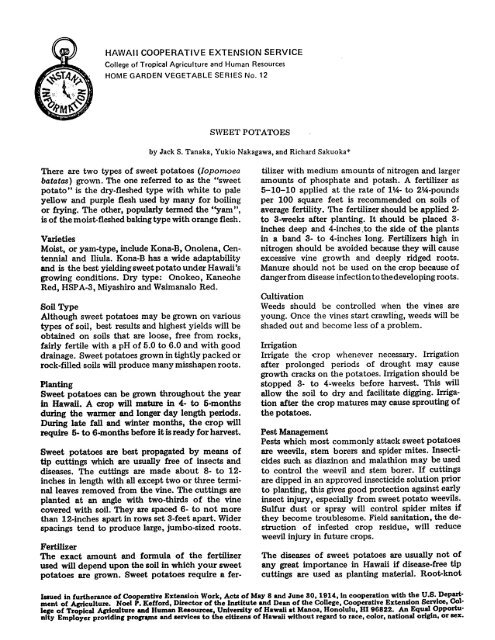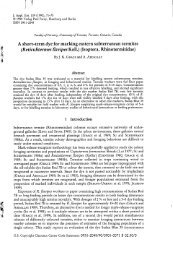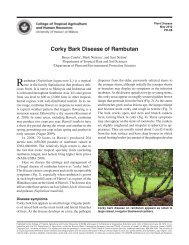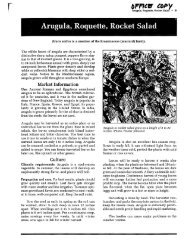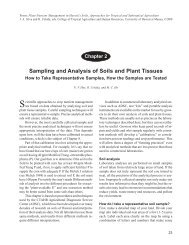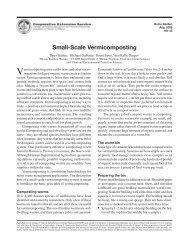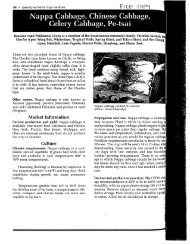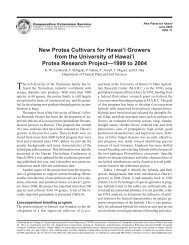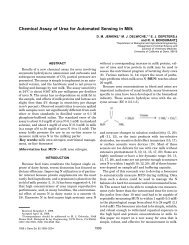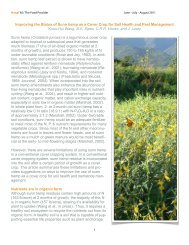Sweet potatoes can be grown throughout the year tion after ... - ctahr
Sweet potatoes can be grown throughout the year tion after ... - ctahr
Sweet potatoes can be grown throughout the year tion after ... - ctahr
Create successful ePaper yourself
Turn your PDF publications into a flip-book with our unique Google optimized e-Paper software.
HAWAII COOPERATIVE EXTENSION SERVICE<br />
College of Tropical Agriculture and Human Resources<br />
HOME GARDEN VEGETABLE SERIES No. 12<br />
SWEET POTATOES<br />
by Jack S. Tanaka, Yukio Nakagawa, and Richard Sakuoka*<br />
There are two types of sweet <strong>potatoes</strong> (Iopomoea<br />
batatas) <strong>grown</strong>. The one referred to as <strong>the</strong> "sweet<br />
potato" is <strong>the</strong> dry-fleshed type with white to pale<br />
yellow and purple flesh used by many for boiling<br />
or frying. The o<strong>the</strong>r, popularly termed <strong>the</strong> 'Vam",<br />
is of <strong>the</strong> moist-fleshed baking type with orange flesh.<br />
Varieties<br />
Moist, or yam-type, include Kona-B, Onolena, Cen<br />
tennial and Iliula. Kona-B has a wide adaptability<br />
and is<br />
<strong>the</strong> <strong>be</strong>st yielding sweet potato under Hawaii's<br />
growing condi<strong>tion</strong>s. Dry type: Onokeo, Kaneohe<br />
Red, HSPA-3, Miyashiro and Waimanalo Red.<br />
Soil Type<br />
Although sweet <strong>potatoes</strong> may <strong>be</strong> <strong>grown</strong> on various<br />
types of soil, <strong>be</strong>st results and highest yields will <strong>be</strong><br />
obtained on soils that are loose, free from rocks,<br />
fairly fertile with a pH of 5.0 to 6.0 and with good<br />
drainage.<br />
<strong>Sweet</strong> <strong>potatoes</strong> <strong>grown</strong> in tightly packed or<br />
rock-filled soils will produce many misshapen roots.<br />
Planting<br />
<strong>Sweet</strong> <strong>potatoes</strong> <strong>can</strong> <strong>be</strong> <strong>grown</strong> <strong>throughout</strong> <strong>the</strong> <strong>year</strong><br />
in Hawaii. A crop will mature in 4- to 5-months<br />
during <strong>the</strong> warmer and longer day length periods.<br />
During late fall and winter months, <strong>the</strong> crop will<br />
require 5- to 6-months <strong>be</strong>fore it is ready for harvest.<br />
<strong>Sweet</strong> <strong>potatoes</strong> are <strong>be</strong>st propagated by means of<br />
tip cuttings which are usually free of insects and<br />
diseases. The cuttings are made about 8- to 12-<br />
inches in length with all except two or three termi<br />
nal leaves removed from <strong>the</strong> vine. The cuttings are<br />
planted at an angle with two-thirds of <strong>the</strong> vine<br />
covered with soil. They are spaced 6- to not more<br />
than 12-inches apart in rows set 3-feet apart. Wider<br />
spacings tend to produce large, jumbo-sized roots.<br />
Fertilizer<br />
The exact amount and formula of <strong>the</strong> fertilizer<br />
used will depend upon <strong>the</strong> soil in which your sweet<br />
<strong>potatoes</strong> are <strong>grown</strong>. <strong>Sweet</strong> <strong>potatoes</strong> require a fer<br />
tilizer with medium amounts of nitrogen and larger<br />
amounts of phosphate and potash. A fertilizer as<br />
5-10-10 applied at <strong>the</strong> rate of IVa- to 2V4-pounds<br />
per 100 square feet is recommended on soils of<br />
average fertility. The fertilizer should <strong>be</strong> applied 2-<br />
to 3-weeks <strong>after</strong> planting. It should <strong>be</strong> placed 3-<br />
inches deep and 4-inches .to <strong>the</strong> side of <strong>the</strong> plants<br />
in a band 3- to 4-inches long. Fertilizers high in<br />
nitrogen should <strong>be</strong> avoided <strong>be</strong>cause <strong>the</strong>y will cause<br />
excessive vine growth and deeply ridged roots.<br />
Manure should not <strong>be</strong> used on <strong>the</strong> crop <strong>be</strong>cause of<br />
danger from disease infec<strong>tion</strong> to <strong>the</strong> developing roots.<br />
Cultiva<strong>tion</strong><br />
Weeds should <strong>be</strong> controlled when <strong>the</strong> vines are<br />
young. Once <strong>the</strong> vines start crawling, weeds will <strong>be</strong><br />
shaded out and <strong>be</strong>come less of a problem.<br />
Irriga<strong>tion</strong><br />
Irrigate <strong>the</strong> crop whenever necessary. Irriga<strong>tion</strong><br />
<strong>after</strong> prolonged periods of drought may cause<br />
growth cracks on <strong>the</strong> <strong>potatoes</strong>. Irriga<strong>tion</strong> should <strong>be</strong><br />
stopped 3- to 4-weeks <strong>be</strong>fore harvest. This will<br />
allow <strong>the</strong> soil to dry and facilitate digging. Irriga<br />
<strong>tion</strong> <strong>after</strong> <strong>the</strong> crop matures may cause sprouting of<br />
<strong>the</strong> <strong>potatoes</strong>.<br />
Pest Management<br />
Pests which most commonly attack sweet <strong>potatoes</strong><br />
are weevils, stem borers and spider mites. Insecti<br />
cides such as diazinon and malathion may <strong>be</strong> used<br />
to control <strong>the</strong> weevil and stem borer. If cuttings<br />
are dipped in an approved insecticide solu<strong>tion</strong> prior<br />
to planting, this gives good protec<strong>tion</strong> against early<br />
insect injury, especially from sweet potato weevils.<br />
Sulfur dust or spray will control spider mites if<br />
<strong>the</strong>y <strong>be</strong>come troublesome. Field sanita<strong>tion</strong>, <strong>the</strong> de<br />
struc<strong>tion</strong> of infested crop residue, will reduce<br />
weevil injury in future crops.<br />
The diseases of sweet <strong>potatoes</strong> are usually not of<br />
any great importance in Hawaii if disease-free tip<br />
cuttings are used as planting material. Root-knot<br />
Issued in fur<strong>the</strong>rance of Cooperative Extension Work, Acts of May 8 and June 30,1914, in coopera<strong>tion</strong> with <strong>the</strong> U.S. Depart<br />
ment of Agriculture. Noel P. Kefford, Director of <strong>the</strong> Institute and Dean of <strong>the</strong> College, Cooperative Extension Service, Col<br />
lege of Tropical Agriculture and Human Resources, University of Hawaii at Manoa, Honolulu, HI 96822. An Equal Opportu<br />
nity Employer providing programs and services to <strong>the</strong> citizens of Hawaii without regard to race, color, na<strong>tion</strong>al origin, or sex.
nematodes may <strong>be</strong>come troublesome, causing pim<br />
ple-like growth on <strong>the</strong> roots. Preplant soil treat<br />
ment with a nematicide will control <strong>the</strong> nematodes.<br />
CAUTION: When using pesticide chemicals,<br />
always read <strong>the</strong> la<strong>be</strong>l carefully and follow <strong>the</strong>'<br />
direc<strong>tion</strong>s for use, storage and disposal and all<br />
o<strong>the</strong>r precau<strong>tion</strong>ary measures.<br />
Harvesting<br />
<strong>Sweet</strong> <strong>potatoes</strong> will <strong>be</strong> ready for harvest from 4- to<br />
6-months <strong>after</strong> planting date. Plants left to grow<br />
more than 6-months will produce large, jumbo<br />
roots. They also have a greater chance of <strong>be</strong>coming<br />
infested with <strong>the</strong> weevils or infected with diseases.<br />
The crop should <strong>be</strong> harvested with care so as to<br />
prevent bruising of <strong>the</strong> roots. The vines are cut at<br />
<strong>the</strong> base and removed <strong>be</strong>fore digging which should<br />
<strong>be</strong> done when <strong>the</strong> soil is dry, to get clean roots free<br />
from any adhering soil. If <strong>the</strong> digging must <strong>be</strong> done<br />
in wet soil, <strong>the</strong> <strong>potatoes</strong> should not <strong>be</strong> washed but<br />
left exposed in. <strong>the</strong> rows, or in a sheltered area, until<br />
<strong>the</strong> adhering soil dries out and is easily brushed off<br />
of <strong>the</strong> <strong>potatoes</strong>.<br />
Curing & Storing<br />
The primary purpose of curing sweet <strong>potatoes</strong> is to<br />
heal cuts and bruises quickly, with a minimum of<br />
shrinkage. They should <strong>be</strong> cured for about 10-days<br />
<strong>after</strong> digging. Also in <strong>the</strong> curing process, some<br />
starches are converted to sugars, thus giving <strong>the</strong><br />
<strong>potatoes</strong> a sweet flavor. Curing takes place faster at<br />
85°F., with a high relative humidity. In most low<br />
land areas, <strong>the</strong> temperature and humidity are such<br />
that curing <strong>can</strong> <strong>be</strong> done merely by storing <strong>the</strong><br />
sweet <strong>potatoes</strong> in a ventilated, rat-proof shed for 2-<br />
to 3-weeks. After curing, <strong>the</strong> roots should <strong>be</strong><br />
stored at a temperature of 55° F. to 70°F Tem<br />
peratures <strong>be</strong>low 50° F. will damage <strong>the</strong> roots Tem<br />
peratures above 70° F. may cause excessive shrink<br />
age and sprouting.<br />
♦Assistant Horticulturist, Specialist in Horticulture, and<br />
Seed Specialist, respectively.<br />
NOTE: Use of trade names is for <strong>the</strong> convenience of <strong>the</strong><br />
readers, only, and does not constitute an endorsement of<br />
<strong>the</strong>se products by <strong>the</strong>' University of Hawaii at Manoa<br />
College of Tropical Agriculture, Cooperative Extension<br />
service, or <strong>the</strong>ir employees.<br />
March, 1978 (revised)<br />
This publica<strong>tion</strong> was assumed to <strong>be</strong> correct at <strong>the</strong> date of its issue, but it may no longer represent <strong>the</strong><br />
most up-to-date informa<strong>tion</strong> on its subject. In particular, if this publica<strong>tion</strong> contains informa<strong>tion</strong> about<br />
pesticide uses, <strong>the</strong> products men<strong>tion</strong>ed may not currently <strong>be</strong> licensed for sale in Hawai'i or<br />
la<strong>be</strong>led for <strong>the</strong> uses descri<strong>be</strong>d.


